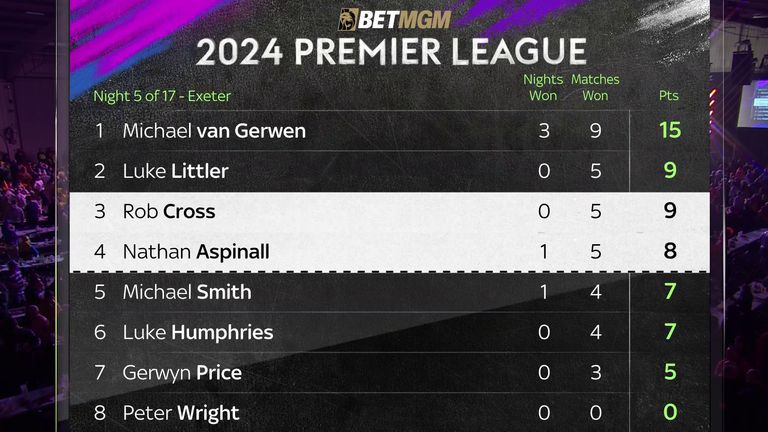Luke Littler, Nathan Aspinall and Michael van Gerwen headline the action; Premier League Darts returns to Sky Sports on Thursday March 7 in Brighton with Night Six; Play-Offs to take place at London’s O2 Arena on May 23

Keep up to date with the 2024 betMGM Premier League fixtures and results as Luke Littler, Michael van Gerwen and Nathan Aspinall get set to headline in Brighton.
The 2024 Premier League Darts format will see eight of the sport’s top stars contesting 16 mini-events during the season, with each league night comprising quarter-finals, semi-finals and a final over the best of 11 legs.
Points will be awarded each night to form the league table, from which the top four players will progress to the Play-Offs, which will be held at The O2 in London on Thursday May 23.
- Stream Sky Sports without a contract through NOW

Image: Premier League Darts Exeter table
Premier League Darts fixtures 2024 – watch all live on Sky Sports
Night One: Thursday February 1, Utilita Arena, Cardiff
Quarter-Finals
Rob Cross 6-3 Peter Wright
Gerwyn Price 6-4 Nathan Aspinall
Michael Smith 6-5 Michael van Gerwen
Luke Littler 6-2 Luke Humphries
Semi-Finals
Gerwyn Price 6-2 Rob Cross
Michael Smith 6-5 Luke Littler
Final
Michael Smith 6-2 Gerwyn Price

Michael Smith and Luke Humphries were both clearly angered by repeated whistling during their betMGM Premier League matches against Luke Littler in Cardiff
Night Two: Thursday February 8, Mercedes-Benz Arena, Berlin
Quarter-Finals
Nathan Aspinall 6-4 Michael van Gerwen
Michael Smith 6-4 Gerwyn Price
Luke Littler 6-5 Rob Cross
Luke Humphries 6-5 Peter Wright
Semi-Finals
Michael van Gerwen 6-5 Michael Smith
Luke Littler 6-5 Luke Humphries
Final
Michael van Gerwen 6-5 Luke Littler

Michael van Gerwen edged Littler 6-5 in a dramatic last-leg decider on night two of Premier League Darts
Night Three: Thursday February 15, OVO Hydro, Glasgow
Quarter-Finals
Rob Cross 6-4 Michael Smith
Michael van Gerwen 6-2 Peter Wright
Luke Humphries 6-3 Nathan Aspinall
Gerwyn Price 6-5 Luke Littler
Semi-Finals
Michael van Gerwen 6-4 Rob Cross
Luke Humphries 6-3 Gerwyn Price
Final
Michael van Gerwen 6-5 Luke Humphries

Gerwyn Price and Littler played out an enthralling encounter in their quarter-final match in Glasgow
Night Four: Thursday February 22, Utilita Arena, Newcastle
Quarter-Finals
Michael Smith 5-6 Nathan Aspinall
Rob Cross 6-5 Luke Humphries
Peter Wright 5-6 Luke Littler
Gerwyn Price 4-6 Michael van Gerwen
Semi-Finals
Nathan Aspinall 6-4 Rob Cross
Luke Littler 5-6 Michael van Gerwen
Final
Nathan Aspinall 4-6 Michael van Gerwen

Van Gerwen was left hanging by Littler ahead of their deciding leg during their semi-final match in Newcastle
Night Five: Thursday February 29, Westpoint Exeter
Quarter-Finals
Luke Humphries 6-3 Michael van Gerwen
Nathan Aspinall 6-4 Peter Wright
Gerwyn Price 1-6 Rob Cross
Luke Littler 6-3 Michael Smith
Semi-Finals
Luke Humphries 5-6 Nathan Aspinall
Rob Cross 6-3 Luke Littler
Final
Nathan Aspinall 6-2 Rob Cross

Nathan Aspinall hits his second 160 checkout of the night in Exeter
Night Six: Thursday March 7, The Brighton Centre
Quarter-Finals
Luke Humphries vs Gerwyn Price
Rob Cross vs Michael van Gerwen
Nathan Aspinall vs Luke Littler
Michael Smith vs Peter Wright
Night Seven: Thursday March 14, Motorpoint Arena, Nottingham
Quarter-Finals
Peter Wright vs Gerwyn Price
Luke Humphries vs Michael Smith
Michael van Gerwen vs Luke Littler
Rob Cross vs Nathan Aspinall
Night Eight: Thursday March 21, 3Arena, Dublin
Fixtures confirmed following Night Seven
Night Nine: Thursday March 28, SSE Arena, Belfast
Quarter-Finals
Luke Humphries vs Luke Littler
Michael Smith vs Michael van Gerwen
Nathan Aspinall vs Gerwyn Price
Rob Cross vs Peter Wright
Night Ten: Thursday April 4, AO Arena, Manchester
Quarter-Finals
Nathan Aspinall vs Rob Cross
Luke Littler vs Michael van Gerwen
Michael Smith vs Luke Humphries
Gerwyn Price vs Peter Wright
Night 11: Thursday April 11, Utilita Arena, Birmingham
Quarter-Finals
Peter Wright vs Luke Humphries
Rob Cross vs Luke Littler
Gerwyn Price vs Michael Smith
Michael van Gerwen vs Nathan Aspinall
Night 12: Thursday April 18, Rotterdam Ahoy
Quarter-Finals
Michael Smith vs Luke Littler
Rob Cross vs Gerwyn Price
Peter Wright vs Nathan Aspinall
Michael van Gerwen vs Luke Humphries
Night 13: Thursday April 25, M&S Bank Arena, Liverpool
Quarter-Finals
Luke Littler vs Gerwyn Price
Luke Humphries vs Nathan Aspinall
Peter Wright vs Michael van Gerwen
Michael Smith vs Rob Cross
Night 14: Thursday May 2, P&J Live, Aberdeen
Quarter-Finals
Peter Wright vs Michael Smith
Luke Littler vs Nathan Aspinall
Michael van Gerwen vs Rob Cross
Gerwyn Price vs Luke Humphries
Night 15: Thursday May 9, First Direct Arena, Leeds
Quarter-Finals
Michael van Gerwen vs Gerwyn Price
Luke Littler vs Peter Wright
Luke Humphries vs Rob Cross
Nathan Aspinall vs Michael Smith
Night 16: Thursday May 16, Utilita Arena, Sheffield
Fixtures confirmed following Night 15
Play-offs: , Thursday May 23, The O2, London
Semi-Finals / Final TBC
Stream Sky Sports Darts without a contract through NOW
Sourse: skysports.com